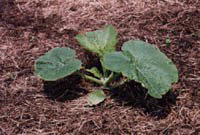| Home
|
| Sustainable Farming Connection |
| Where farmers find and share information. |
Smart Cover Cropping
Rye/vetch/clover mix ensures plenty of biomass and healthy soil for transplanted vegetables.
Groff began using cover crops in 1991 as another soil-conservation measure to complement his no-till practices. "I started using rye for winter erosion control on fields that would have been bare. But now I plant cover crops based on the succeeding crop that I want to plant into it the next year."
Groff no-tills his covers in fall with a JD 750 or Vermeer drill.
 No-tilling tomato transplants saves Groff about $550 per acre. |
- 25 lb./A hairy vetch
- 30 lb./A rye
- 10 lb./A crimson clover
Before direct-seeded crops such as pumpkins, he'll plant 25 lb./A of vetch alone or with 1 bu./A oats that will winterkill, or rye alone at 2 to 3 bu./A if it's too late to plant vetch.
 Cover crop mulch reduces soil splash, keeping squash and pumpkins cleaner. |
Groff has been experimenting with 'AU Early Cover,' a new variety of hairy vetch developed by the NRCS and the Alabama Experiment Station. (Seed is available from P.L. Rohrer & Bro., 2472 Old Philadelphia Pike, Smoketown, Pa. 17576. Phone: (717) 299-2571.) The new variety flowers earlier than common hairy vetch, making it easier to kill early in the season.
Vetch can be killed mechanically once the plant has initiated flowering. Waiting until about 25 percent of the plants show purple flowers assures that later-flowering plants also will be killed.
There is still concern that this experimental vetch may not be reliably winterhardy this far north. But Groff had no problems with overwintering when he drilled it at 35 lb./A along with rye at 40 lbs/A in late September '95. It matured 10 days earlier than common hairy vetch planted at the same time in the same field. Both were 52 inches tall, produced 1,100 lb./A of dry matter and had the equivalent of 150 lb./A of nitrogen in the aboveground portion of the plants.
Groff also drills warm-season summer annuals -- such as a mix of 20 lb./A of German millet and 60 lb./A of forage soybeans -- in late April or early May. By mid-July, the soybeans are typically 6 feet tall when he rolls them with the stalk chopper before planting a fall broccoli crop. "The beans provide a nice soil-protecting cover that also keeps weeds down," he says.
While the beans provide some of the nitrogen for the broccoli, Groff doesn't think they provide enough when planted in combination with the millet. In '97, he plans to try drilling the beans alone.
 Hairy vetch cover crops supply Groff's corn with nitrogen and reduce erosion. |
 |
Groff's Guide To No-Till Transplanting |
  Video Video Smart Cover Cropping Smart Cover Cropping
 Transplanter
and Stalk-Chopper Modifications Transplanter
and Stalk-Chopper Modifications Test Plot Results Test Plot Results '97 Journal
Follow Steve's management strategies through the season. '97 Journal
Follow Steve's management strategies through the season.
|
| Top of Page |
| Home
|
©1998 Committee for Sustainable Farm Publishing
Please read about our usage permission policy and disclaimer.
Send comments, suggestions and questions to the site author:
Craig Cramer cdcramer@clarityconnect.com
Coded using HoTMetaL Pro 3.0. Best viewed in Netscape 3.0 or later.
Please see our credits page for more information.
http://sunsite.unc.edu/farming-connection/covercro/groff/coverman.htm